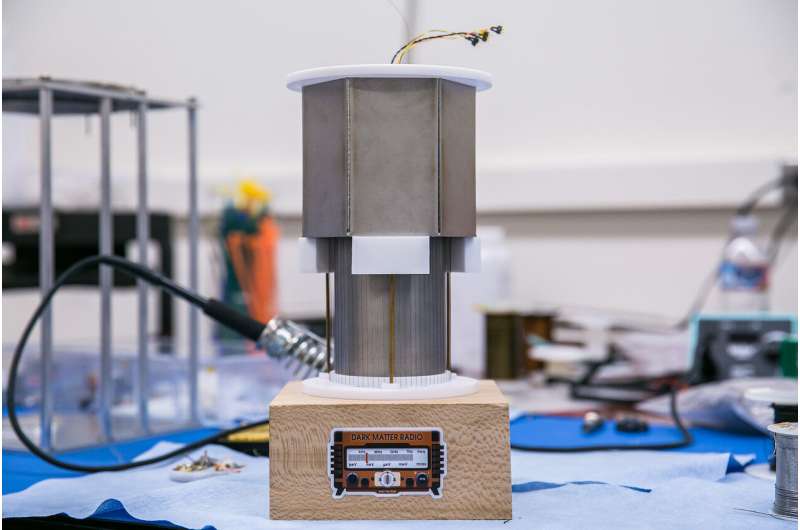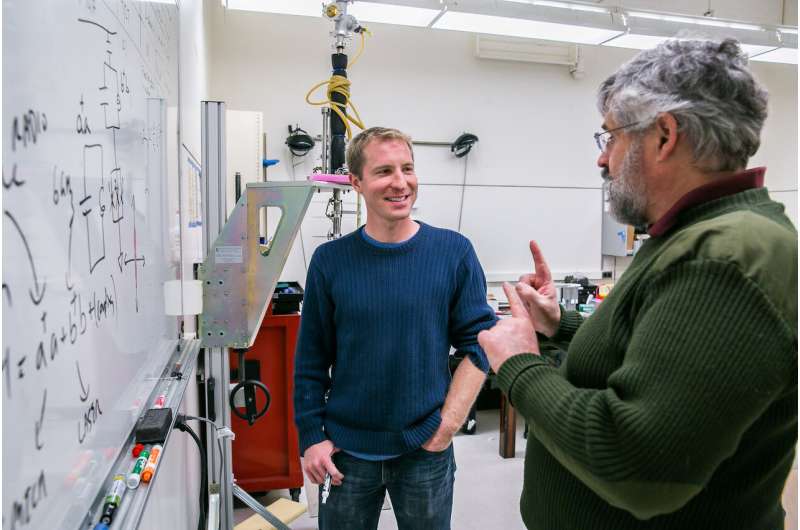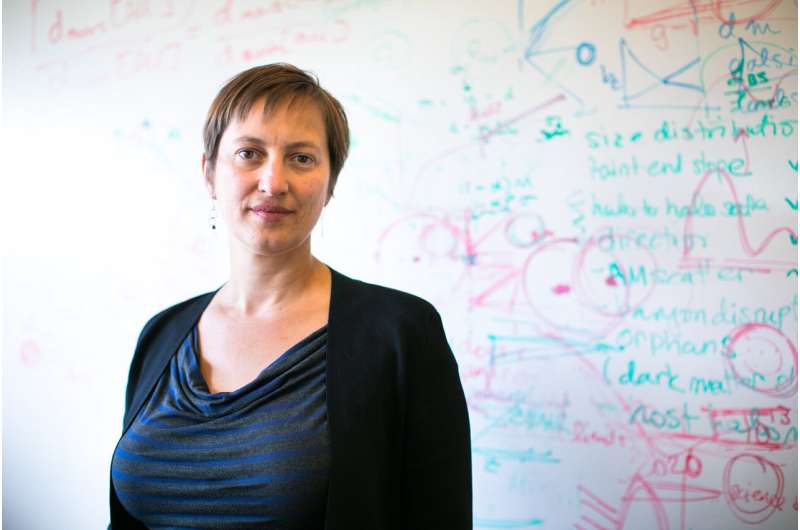The dark matter radio is a tabletop device that could explain the mysterious matter that makes up 85 percent of the mass of our universe. Credit: Harrison Truong
A team of Stanford University researchers are on a mission to identify dark matter once and for all. But first, they'll need to build the world's most sensitive radio.
"Dark matter is most of the matter in our universe. We don't know what it is but we know it's there because we can see its gravitational effects," explained Peter Graham, an associate professor of physics in Stanford's School of Humanities and Sciences and one of the leaders of this search for dark matter. "We also know it has to be made out of a totally different particle with different properties than anything we've ever found."
Graham and Savas Dimopoulos, the Hamamoto Family Professor in physics at Stanford, have developed theories about dark matter that advocate for high-precision experiments focused on finding axions, theorized particles that are among the most likely candidates for dark matter. Their theories—once considered "interesting but out there," according to Graham—are gaining popularity as other candidates for dark matter get ruled out and new technologies are making their exacting experiments possible. Now the Gordon and Betty Moore Foundation have granted Stanford researchers roughly $2.5 million to prototype a new kind of dark matter sensor.
Guided by Graham and Dimopoulos' theories, Kent Irwin, a professor of physics, of particle physics and astrophysics and of photon science at Stanford and SLAC National Accelerator Laboratory, is building the Dark Matter Radio, which will search for the signal of axions the same way a standard AM radio picks up a broadcast. Like an AM radio station, axion dark matter has a precise frequency, but this frequency is unknown. Due to advances in quantum sensors, the radio will be much more sensitive than past dark matter experiments, and able to scan a large swath of the frequencies that are most likely to reveal axions.
"This project is a really beautiful example of people with very different expertise coming together to solve a hard problem," said Risa Wechsler, director of the Kavli Institute for Particle Astrophysics and Cosmology (KIPAC) and professor of physics and of particle physics and astrophysics. "Dark matter is 85 percent of the mass in the universe and I think it's very unlikely that we would exist without it. The exciting thing about this experiment is that it opens up so much discovery space that was previously inaccessible."
Even if the researchers don't find the axion, their work would have the distinction of searching a significant fraction of its possible frequency range. The researchers are also excited to see how their sensor development will contribute to spinoff applications in various fields.
Peter Graham and Kent Irwin are building a tabletop-sized device to detect dark matter. Credit: Harrison Truong
The Dark Matter Radio
Dark matter makes up most of the mass in the universe, but each axion is theorized to have such a low mass—falling in the category of ultra-light dark matter—that it might spread out over kilometers. Quantum mechanics, which is the study of behavior of extremely small particles, contends that every particle also behaves like a wave. So, if axions do exist, they're rippling all around us like a radio signal. The Dark Matter Radio team will scan for the frequency that carries the signal from the wave-like undulations of this ocean of overlapping axions.
The first trick is to convert axion waves into radio waves—carried out by a strong magnetic field inside the Dark Matter Radio. The Dark Matter Radio is also surrounded by a superconducting shield of niobium that blocks out regular radio signals, but will let axions through.
Even with all these enhancements, axions will give off a very weak signal. So, the radio's tuning has to be incredibly sharp—the equivalent of a car radio that can detect stations separated by one one-millionth of a decimal place. As part of achieving this level of sensitivity and precision, Irwin is working with a new type of quantum sensor that is capable of picking up magnetic signals a hundred million trillion times smaller than what is produced by a typical refrigerator magnet.
"There's been a breakthrough in the ability to control, create and manipulate quantum states in ways that allow us to take advantage of theory that's been around for many decades," said Irwin. "These are some of the same techniques that are being used to develop quantum computers. Instead of using them to compute, we can measure things much more sensitively and precisely than we could before, and the techniques we're using will have broad applications."
The same quantum sensors that the researchers are building into the radio could also enhance the precision of medical scanning techniques that measure the properties of magnetic and electric fields in the human body.
Risa Wechsler, professor of physics and of particle physics and astrophysics. Credit: Holly Hernandez
Beyond the whiteboard
So far, the researchers have successfully built a soda-can-sized prototype of the dark matter radio that works as an extra-sensitive AM radio. They are currently working on a larger version that will be able to scan all the frequencies of interest with enough sensitivity to measure axion dark matter.
"Most of the ideas that we theorists have fail before they ever get anywhere, so it was a big deal to see this crazy idea that we had on a whiteboard become a physical thing," said Graham. "The experimentalists, like Kent, still have a lot of work ahead of them but for me, it feels like the culmination of so many years of work. The Dark Matter Radio is going to be real. It's going to happen."
Provided by Stanford University

























